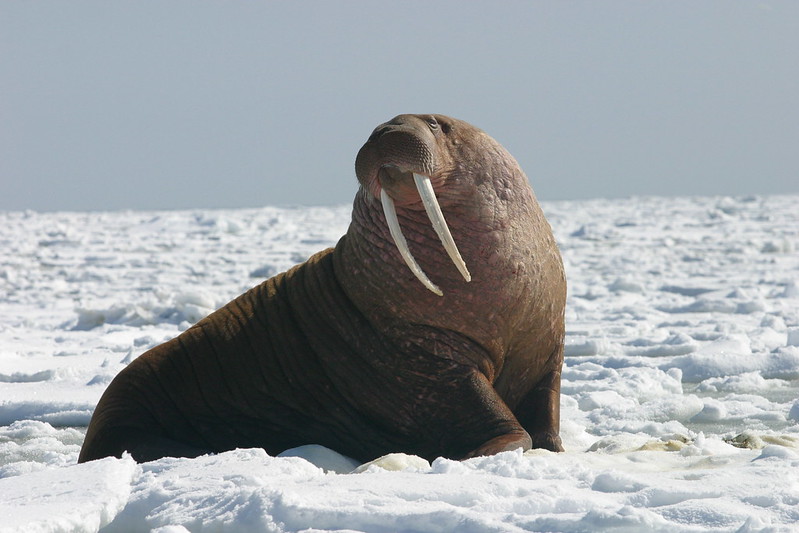
Walrus Facts
- This massive product of Nature and evolution most frequently goes by the short common name of Walrus across its range. It currently has no other broadly accepted general name. Though certain not unknown, that’s nonetheless somewhat uncommon.
- It’s the only surviving member of its Family. The appellation holds yet another unusual status. That’s because of the fact that the same term also applies to two separate recognized subspecies. Those consist of the Atlantic Walrus and the Pacific Walrus.
- Among scientific professionals, however, a different moniker typically applies. That’s true since its technical title generally predominates in such situations. Unfortunately for the layperson, though, that’s the hard to pronouce epithet Odobenus rosmarus.
- The creature received that designation due to the efforts of Carl Linnaeus. The highly esteemed Swedish zoologist accomplished the first recognition of it as a separate and distinct species, originally. That noteworthy deed occurred in 1758.
- Sadly, the amazing Walrus presently finds itself in somewhat dire straits. Its population suffered drastically in the past, due to human activities. Though it enjoys protected status now, the species is still suffering the effects of prolonged hunting practices.
- Now, however, it also faces other threats to its continued existence. Give its precarious situation, the IUCN currently lists it as Vulnerable on its Red List. The major dangers it faces consist of the related troubles of habitat loss and ongoing climate change.
Related Articles
Walrus Physical Description
The magnificent Walrus is a work of Nature that fully merits the respect and appreciation it typically receives from those who view it. The pinniped does so, however, due to more than its unique appearance. That’s true since it’s also a highly impressive-sized animal.
It also shares a trait common to many, if not most, animals. That’s the fact that it displays a certain degree of the physiological characteristic of sexual dimorphism. Though this varies between the two subspecies, generally speaking, females show different size and color.
On average, the Pacific subspecies attains the greater dimensions of the two. In this subspecies, as well as the other, males reach larger average sizes than their female counterparts. These measure an average of 18% longer and 45% heavier than the females.
Males of the larger subgroup typically achieve truly impressive stature. In fact, they rank as the third largest of all pinnipeds. A mean body length equals roughly 9 – 12 ft (2.7 – 3.6 m). Meanwhile, weights generally range from 1,764 – 3,748 lb (800 – 1,700 kg).
Females of the subgroup develop as slimmer in structure, as the percentages indicate. Their overall length usually measures between 7.5 – 10 ft (2.3 – 3.1 m). Masses for them, though, generally range from 882 -2,756 lb (400 – 1,250 kg). Exceptions do occur, however.
The genders of both subdivisions of the amazing Walrus also show differences in terms of color patterns. Overall, this tends to consist of a cinnamon-brown shade. Yet, differences nevertheless appear. Males most often display a slightly lighter hue than females.
Other differences also present themselves to distinguish the two sexes. In addition to be lighter colored, the skin of males usually develops as thicker and less hairy than females. The powerful males also possess significantly longer and thicker tusks than their counterparts.
- Kingdom: Animalia
- Phylum: Chordata
- Class: Mammalia
- Order: Carnivora
- Family: Odobenidae
- Genus: Odobenus
- Species: O. rosmarus
Walrus Distribution, Habitat, and Ecology
Both subspecies of the intriguing Walrus evolved as native to a very specific portion of the globe. As a greater principle, this consists of a moderately large expanse of the earth’s surface. The location of that zone of habitation likely won’t surprise many readers, though.
The two groups developed as endemic to part of the Arctic Ocean region. The Pacific walrus primarily lives north of the Bering Strait in summer, including the regions near such places as northern Alaska. In spring and fall they move to the western area of that range.
The Atlantic walrus, with its much smaller population, though, lives in a different section of the region. That territory extends roughly from the Arctic parts of Canada, to the western part of Russia. That includes such areas as Grenland and the archipelago of Svalbard.
The marvelous mammal displays decidedly strong preferences regarding its choice of habitat. Due to that, the creature shallow shelf regions along the shoreline. Though capable of diving to depths of as much as 1,640 ft (500 m), it usually remains in shallower waters.
Like its may relatives, the Walrus also evolved as carnivorous in nature. The animal consumes a wide variety of locally available species. It also feeds opportunistically. Nonetheless, the natural wonder does display a preference for mollusks, especially clams.
Given its great size, power, and sharp tusks, this carnivore itself has very few natural predators. In fact, only two known species prey on it, and even then only rarely. These consists of the Orca and the Polar Bear. Even these generally only attack the young calves.
Species Sharing Its Range
Arctic Fox
Chedk out our other articles on 3 Surprising South American Moths, European Honey Buzzard, Victoria Falls, Hairy Shadow Witch, East African Lowland Honey Bee, Mugger Crocodile
